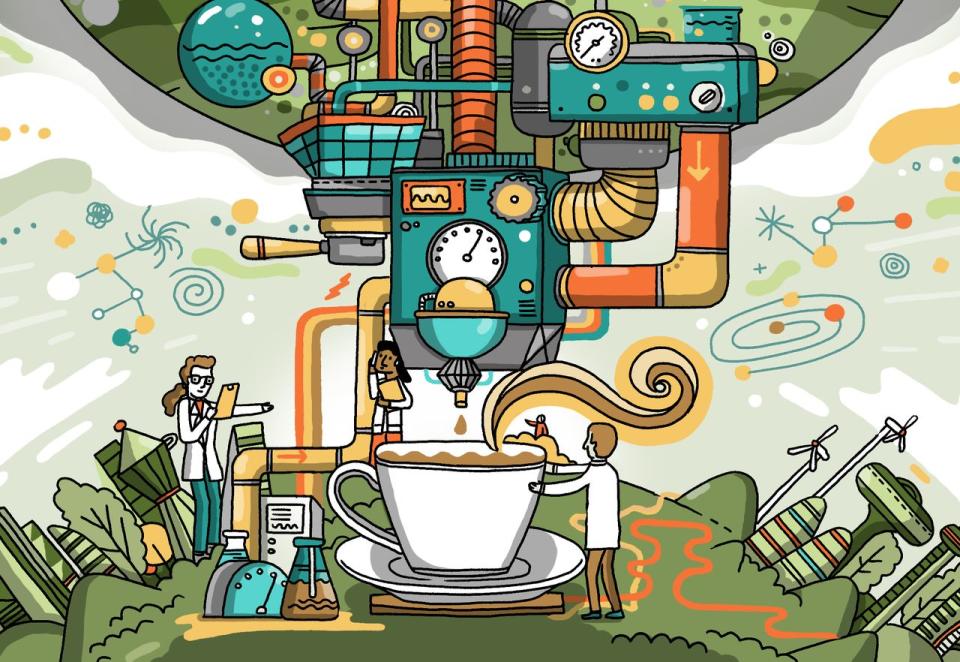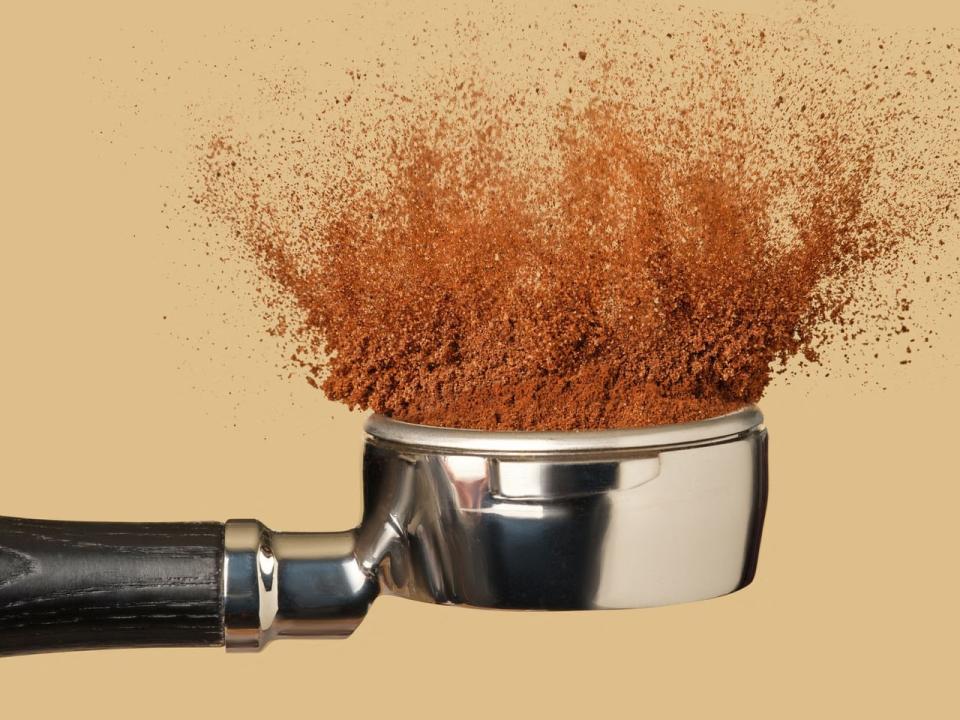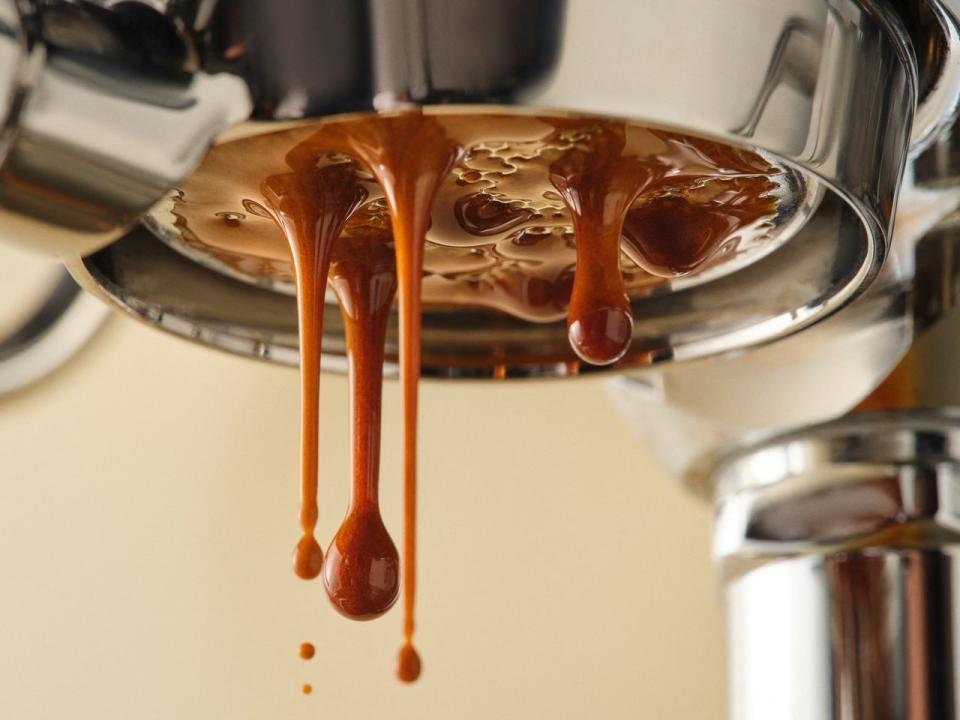Why You May Soon Be Drinking Synthetic Coffee

Your typical morning cup of coffee is a social and environmental disaster—but you’ll soon have the option to start sipping something less harmful: synthetic coffee.
Most Read from The Wall Street Journal
The CEO Who Hired His Wife, Gave His Dog a Title, and Brought Down a Bank
Retailers Scale Back Self-Checkouts to Curb Irritation—and Theft
Worldwide, people consume two billion cups of coffee a day. Given that the average Arabica tree produces only one to two pounds of coffee a year, that means every two-cup-a-day coffee drinker requires continuous production from around 20 coffee trees.
The intense demand for coffee has driven mass deforestation, poverty wages for farmers who see little of the rising prices for their commodity, and substantial carbon emissions due to both production and long supply chains. Research suggests that around half of the land best suited to growing coffee will become unsuitable for that purpose by 2050, thanks to climate change. In Brazil, that figure reaches 88%.
For all of these reasons, at least a half-dozen companies are using biotechnology and food science to replace the coffee in your cup with something that lacks all that baggage, and isn’t nearly as vulnerable to climate change. This pseudo-coffee can be made from a variety of ingredients, including chickpeas and “upcycled” agricultural waste like date pits. Other approaches use lab-grown cells from actual coffee plants. Companies like Voyage Foods, Minus Coffee, Atomo, Prefer, Stem and Northern Wonder have all either begun selling, or are working on, so-called beanless coffee alternatives.
One of the world’s largest food companies, Cargill, has taken notice, and recently signed a deal to become the exclusive business-to-business distributor of beanless-coffee maker Voyage Foods’ cocoa- and nut-free products.
If these companies reach enough people, it will be a classic case of what economists and climate capitalists call the substitution effect: As traditional coffee becomes scarce, and more expensive, consumers will switch to these cheaper and plentiful alterna-brews.

And coffee may just be the beginning. Already, Voyage Foods sells a nut-free, cocoa-free Nutella alternative nationwide at Walmart. The company says its spread is comparable in price to “real” Nutella, and is also the lowest-cost allergen-free spread available at the big-box chain.
For people to convert from brands they know, it needs to cost nothing to make a switch, and the replacement needs to taste good, says Chief Executive Adam Maxwell.
How’s it taste?
Coffee is as much an idea as it is an actual, physical thing, says Voyage Foods’ Maxwell.
“A green coffee bean tastes nothing like a cup of coffee we drink and enjoy,” he says. “The experience we get from coffee or chocolate is really driven by the process used to make them.”
Recently, I had a chance to try the beanless coffee billed by its maker as the highest-end and the most coffee-like. Andy Kleitsch, CEO of Atomo Coffee, brewed me a flight of espressos and espresso-based drinks.
Atomo coffee is made from a handful of fermented and roasted ingredients, including ramon seeds, which have been used in a traditional roasted beverage in South America since long before Spaniards arrived. But the main ingredient is date seeds—that is, what’s left over after a date is mechanically pitted—which would otherwise just be thrown away.
The drinks that were mixed with oat milk—which is how I normally take my coffee—were indistinguishable from those made with traditional coffee beans. The espresso, straight-up, was a bit different. As I raised it to my nose, I detected a bouquet that included familiar notes—chocolate, vanilla, toast—as well as the unexpected. Turmeric and cumin, perhaps?
As for the taste, it’s fine, if a bit mild—lower-acidity than a typical espresso, and not quite as punch-you-in-the-face bitter.
Collectively, its flavor notes, and the mouthfeel of the resulting brewed espresso are enough like the real thing that I’d challenge anyone but a barista in a third-wave coffee shop to tell the difference.
As for Voyage Foods’ cocoa-free spread, I’ve tried it, and if I didn’t know it didn’t have nuts or cocoa in it, I wouldn’t have guessed. The company’s peanut-free peanut butter analogue was a reasonable facsimile of the real thing, but something about it still reminded me of the seeds from which it’s actually made. And as for the company’s coffee? It was a serviceable, if less complex, replacement for either the real thing or Atomo’s brew.
Spaceship coffee for spaceship Earth
Since we’re messing with the life-support system on planet Earth by filling the atmosphere with greenhouse gases, it makes sense that someday we might produce more of our food the way NASA has proposed growing food for space stations and moon bases.
Bioreactors—basically, big steel vessels—have been used for decades to manufacture pharmaceuticals, cosmetics and food additives. Any plant cell can be run through a process that makes it possible for it to grow in a bioreactor, subsisting on nothing but sugars, says Heiko Rischer, head of plant biotechnology at VTT Technical Research Centre of Finland.
Rischer’s team demonstrated in 2021 that it is possible to grow cells from coffee plants inside a bioreactor, and that the resulting powder, when roasted, has many of the characteristics of coffee. Researchers at his institute are also working on a similar process for growing the cells in cocoa plants that give chocolate its distinctive flavor.

Ultimately, there is no limit to what plant cells can be grown in bioreactors, says Rischer. That doesn’t mean this process is magical or a quick fix, since every plant you want to grow this way must be studied individually and has its own requirements.
Cost is an issue—growing coffee and cocoa cells isn’t nearly price-competitive with the real thing yet, even as those commodity prices continue to rise. While his team has already grown enough coffee cells in bioreactors to create a substance that approximates the real thing, it isn’t clear when the process will be scaled up enough for lab-grown cocoa and coffee to be competitive, says Rischer.
The race to be the margarine of coffee
In the future, the biggest competitor for beanless coffee is still likely to be regular coffee—but souped-up and grown in biomes that might become more hospitable as the planet warms.
Using plant breeding to bring desirable traits from wild coffee plants that still exist could lead to hardier trees that can handle more heat stress, as well as the continuing threat of a deadly fungal disease, known as coffee rust, that threatens the global crop. Starbucks announced last year it’s working on breeding coffee trees that will be more resistant to the effects of climate change.
There is also always the possibility of genetically engineered coffee, although it’s likely such plants would have the same environmental issues as much of today’s coffee, in terms of both land use and the emissions impact of transporting beans.
In the late 19th century, shortages of butter spurred chemists to find alternative sources of fats. Margarine, shortening and a variety of hydrogenated fats were born from this effort. The result is that today, most consumers don’t expect a box of Chips Ahoy cookies to be made with real butter.
Is it such a stretch, asks Maxwell, to imagine that in those same cookies, consumers might someday accept that the “chocolate” chips aren’t made from actual cocoa?
Based on my own experience, it also isn’t a stretch that consumers could someday accept a cheaper and more sustainable coffee substitute, especially if the kind that comes from actual coffee trees becomes expensive enough to be reserved only for special occasions.
“In my mind, chocolate and coffee are the experience of consumption,” says Maxwell.
For more WSJ Technology analysis, reviews, advice and headlines,.
Write to Christopher Mims at christopher.mims@wsj.com
